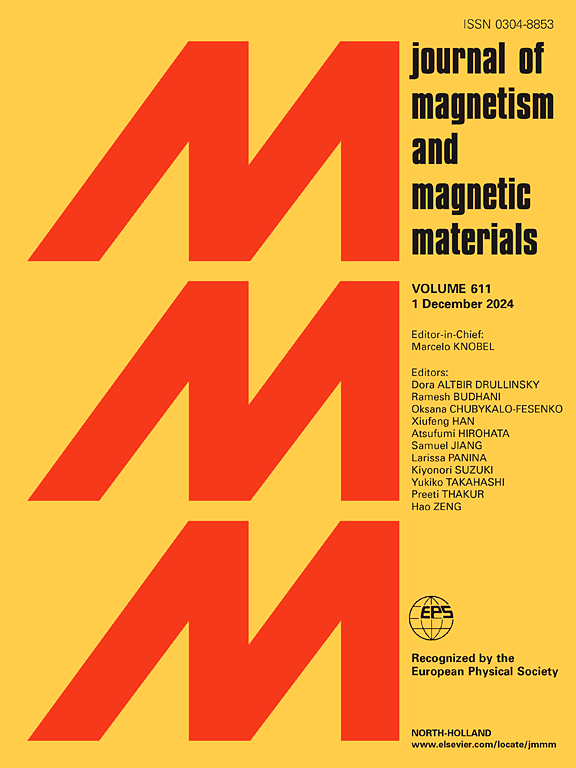超低温下GdPO4纳米球形颗粒的大可逆磁热效应
IF 2.5
3区 材料科学
Q3 MATERIALS SCIENCE, MULTIDISCIPLINARY
引用次数: 0
摘要
采用高温固相反应法制备了单斜晶结构(P21/n)的磷酸钆(GdPO4)。对x射线衍射(XRD)数据进行Rietveld细化,晶格常数为a = 0.66497(5)nm, b = 0.68457(5)nm, c = 0.63327(4)nm。详细研究了GdPO4的磁性和磁热性能。铁磁(FM)向顺磁(PM)相变温度约为1.8 K。Arrott图和描述磁热效应(MCE)的通用现象学曲线有力地支持了这种转变。GdPO4表现出显著的磁熵变化(−ΔSM)。当磁场变化(μ0ΔH)为2 T和9 T时,-ΔSMmax的最大值分别为20.43 J/(kg·K)和44.79 J/(kg·K)。分析表明,GdPO4纳米球形粒子表现为短程磁有序,表现为铁磁(FM)和反铁磁(AFM)相互作用共存。本文章由计算机程序翻译,如有差异,请以英文原文为准。
Large reversible magnetocaloric effect in GdPO4 nano-spherical particles at ultralow temperatures
This study reports the synthesis of gadolinium phosphate (GdPO4) with a monoclinic crystal structure (P21/n) using a high-temperature solid-state reaction method. Rietveld refinement of the X-ray diffraction (XRD) data revealed lattice constants of a = 0.66497(5) nm, b = 0.68457(5) nm, and c = 0.63327(4) nm. The magnetic and magnetocaloric properties of GdPO4 were investigated in detail. The ferromagnetic (FM) to paramagnetic (PM) phase transition temperature was determined to be around 1.8 K. The transition was strongly supported by Arrott plots and a universal phenomenological curve describing the magnetocaloric effect (MCE). GdPO4 exhibits significant magnetic entropy changes (−ΔSM). The maximum values of are 20.43 J/(kg·K) and 44.79 J/(kg·K) for a magnetic field change (μ0ΔH) of 2 T and 9 T, respectively. Our analysis indicates that the GdPO4 nano-spherical particles exhibit short-range magnetic ordering, characterized by the coexistence of ferromagnetic (FM) and antiferromagnetic (AFM) interactions.
求助全文
通过发布文献求助,成功后即可免费获取论文全文。
去求助
来源期刊

Journal of Magnetism and Magnetic Materials
物理-材料科学:综合
CiteScore
5.30
自引率
11.10%
发文量
1149
审稿时长
59 days
期刊介绍:
The Journal of Magnetism and Magnetic Materials provides an important forum for the disclosure and discussion of original contributions covering the whole spectrum of topics, from basic magnetism to the technology and applications of magnetic materials. The journal encourages greater interaction between the basic and applied sub-disciplines of magnetism with comprehensive review articles, in addition to full-length contributions. In addition, other categories of contributions are welcome, including Critical Focused issues, Current Perspectives and Outreach to the General Public.
Main Categories:
Full-length articles:
Technically original research documents that report results of value to the communities that comprise the journal audience. The link between chemical, structural and microstructural properties on the one hand and magnetic properties on the other hand are encouraged.
In addition to general topics covering all areas of magnetism and magnetic materials, the full-length articles also include three sub-sections, focusing on Nanomagnetism, Spintronics and Applications.
The sub-section on Nanomagnetism contains articles on magnetic nanoparticles, nanowires, thin films, 2D materials and other nanoscale magnetic materials and their applications.
The sub-section on Spintronics contains articles on magnetoresistance, magnetoimpedance, magneto-optical phenomena, Micro-Electro-Mechanical Systems (MEMS), and other topics related to spin current control and magneto-transport phenomena. The sub-section on Applications display papers that focus on applications of magnetic materials. The applications need to show a connection to magnetism.
Review articles:
Review articles organize, clarify, and summarize existing major works in the areas covered by the Journal and provide comprehensive citations to the full spectrum of relevant literature.
 求助内容:
求助内容: 应助结果提醒方式:
应助结果提醒方式:


